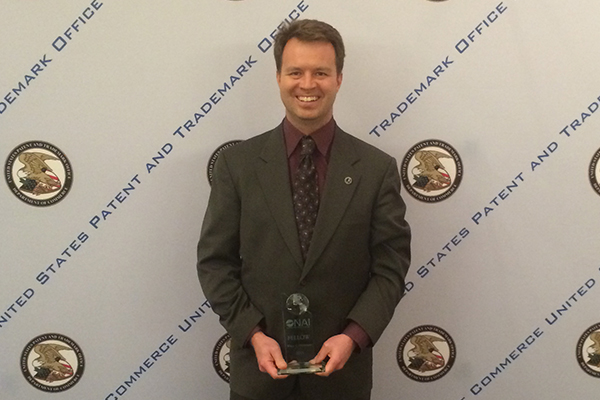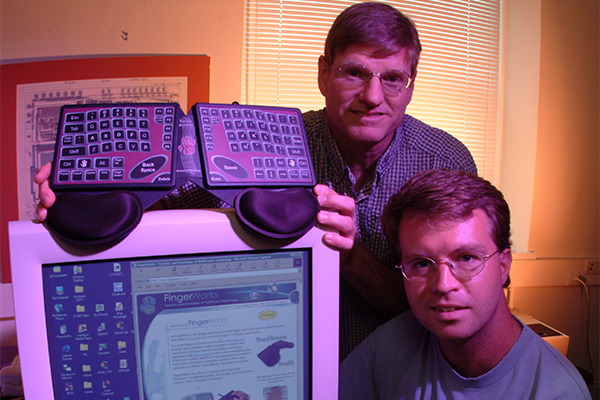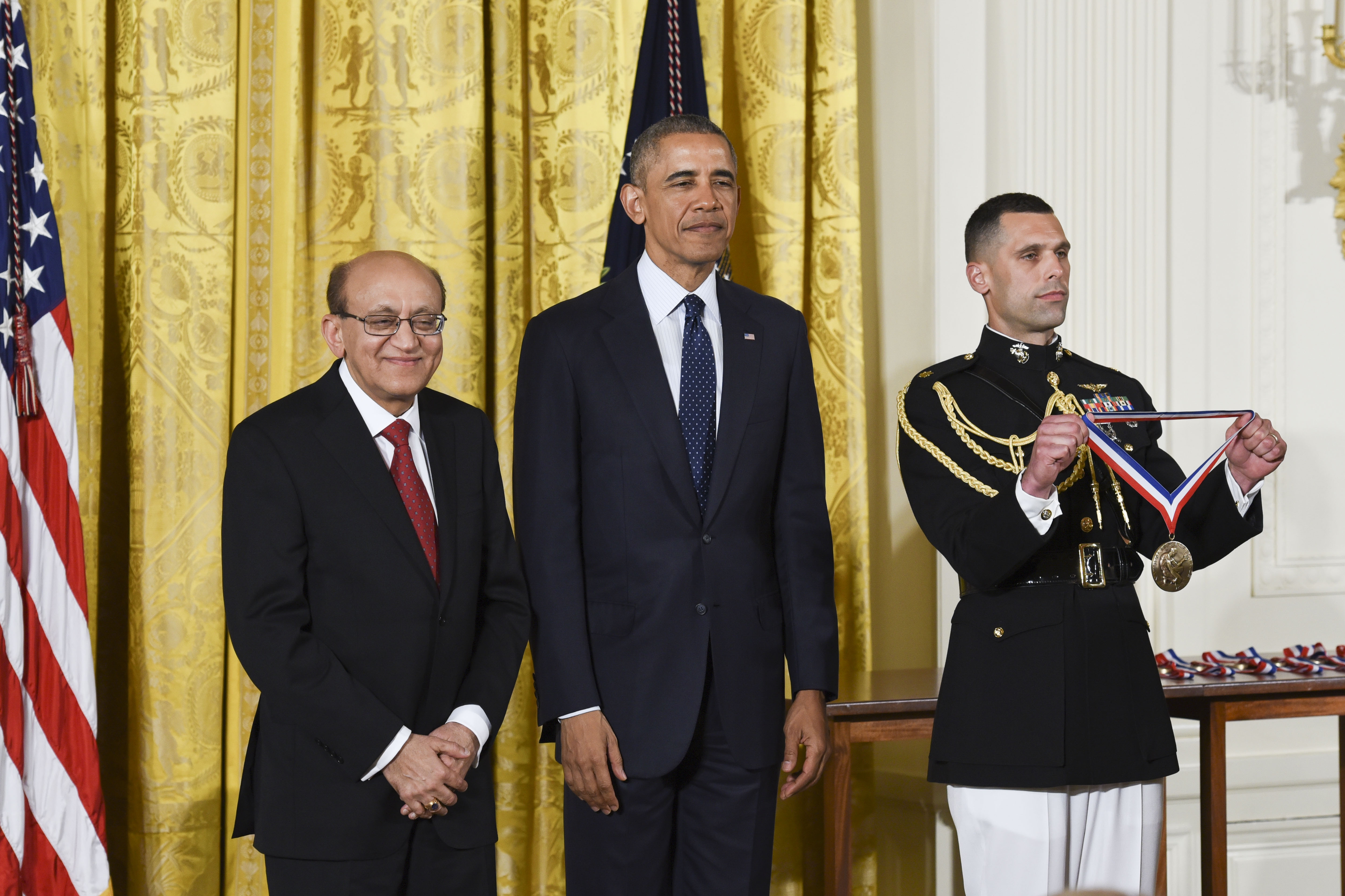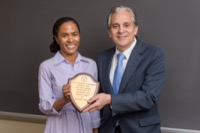Tech pioneers
UD inventors of touch imaging interface technology inducted as NAI Fellows
9:01 a.m., May 27, 2014--University of Delaware alumnus Wayne Westerman and John Elias, adjunct professor of electrical and computer engineering, have been named fellows of the National Academy of Inventors (NAI).
Election to NAI fellow status is a professional distinction accorded to current and former academic inventors. Westerman and Elias were chosen for pioneering the algorithms and touch imaging interface architecture used in many touch screen devices.
Honors Stories
National Medal of Science
Warren Award
The touch imaging interface they created changed the way people interact with computers by incorporating scrolling, finger tracking and gesture recognition, features found in electronic devices worldwide, including the iPod, iPhone and iPad.
“Wayne and John’s success story is a shining example of the entrepreneurial ecosystem that is being nurtured at UD. It illustrates what can happen when an innovation in academic research is matched with a market need and translated into real world products,” said Brad Yops, director of UD’s Technology Transfer Center, who nominated Westerman and Elias for the award.
UDaily talked with Westerman about the original motivation behind the touch imaging invention and the importance of instilling an entrepreneurial mindset in today’s students.
Q: What was the original motivation behind your touch imaging invention?
Westerman: I joined Dr. Elias' lab in 1995 to study neural computation by building and experimenting with silicon dendrites — one of the main computational elements in the brain. I had tendonitis and this motivated me to tinker with different types of input technology. I noticed my hands had much more endurance with zero-force input like optical buttons and capacitive touch pads than force-actuating keys and buttons (that were stiffer twenty years ago than today).
Q: Was there a Eureka moment in your research?
Westerman: Trying to pick a dissertation topic, I considered training our neuromorphic silicon circuits to recognize handwriting patterns — hundreds of researchers had already tackled handwriting with simpler methods.
The Eureka moment was when I imagined training the neural simulator with multi-finger patterns from a zero-force tablet. We began looking for one but there were no such tablets on the market. The touch pad manufacturers of the day told Dr. Elias that their products could not process multi-finger input. Since I played piano, using all ten fingers seemed fun and natural and inspired me to create interactions that flowed more like playing a musical instrument.
Q: What do you think contributed to your success?
Westerman: Dr. Elias’ expertise building custom circuits and computers was uncommon amongst professors, but luckily was just the expertise needed to prototype (and eventually manufacture) advanced input devices. Our early experiments with surface typing for desktop computers were met with skepticism, but the algorithms we invented helped surface typing feel crisp, airy and reasonably accurate despite the lack of tactile feedback. Hundreds of millions of people now utilize surface typing on mobile devices.
Q: What elements of an entrepreneurial mindset are key for today’s engineers?
Westerman: Whether you're an engineer with an independent streak who wants to found your own startup, or you're more comfortable within a stable corporation, shipping any new idea requires enormous determination, creativity and coordination. Serial entrepreneurs bring a relentless, unstoppable attitude to problem solving; they share a mindset that embraces each obstacle — be it excessive product complexity, manufacturing cost, organizational or marketing weakness — as solvable through creative exploration, even if that exploration ultimately sets them upon a totally unexpected path.
Q: What lessons have you learned that might help future innovators?
Westerman: Entrepreneurs must be practical enough to recognize the flaws in their product vision and iterate, often for years, until enough flaws are resolved for market success. To introduce something truly new, it also helps to have a contrarian streak that leads away from the crowd towards fertile areas that others haven't yet pursued. If your ideas are truly new (or also if they're “batty”), the crowd will be skeptical initially. You must decide whether you're on the right path and, if so, keep pushing.
Q: What influence has University of Delaware had on your career success?
Westerman: The diverse courses and environment at UD go a long way to prepare students for joining a startup or corporation where working in cross-disciplinary teams is standard. I garnered lots of insights into input device ergonomics by sitting in on a biomechanics class in UD's physical therapy department, taking product design inspiration from facts that were intended as therapy training for the other students. Working within UD electrical and computer engineering's friendly department atmosphere gave me the support and freedom to wander through several zany research topics until I found a new cross-disciplinary niche.
About Westerman and Elias
The touch-sensitive imaging technology grew out of Wayne Westerman’s UD doctoral thesis. He developed the revolutionary computer interface technology with John Elias, then a UD professor in the College of Engineering, who began developing multitouch user interfaces for portable and desktop computer systems in 1995.
Westerman and Elias co-founded FingerWorks Inc. in 1998. It was the first company to commercialize touch-sensitive imaging technology with a line of 10-finger touch pads and keyboards that seamlessly combined typing, pointing, scrolling, and editing gestures within the same surface area. Their early work at UD was supported in part by the National Science Foundation. Apple acquired the company in 2005.
Westerman is named on 64 issued U.S. patents, 118 foreign patents and 217 pending applications. Elias is named on over 135 patents and 115 pending applications.
They are part of the National Academy of Inventors 2013 College of Fellows, which includes 26 presidents and senior leadership of research universities and non-profit research institutes, 69 members of the National Academies (National Academy of Sciences, National Academy of Engineering, Institute of Medicine), five inductees of the National Inventors Hall of Fame, six recipients of the U.S. National Medal of Technology and Innovation, two recipients of the U.S. National Medal of Science and nine Nobel Laureates, among other major awards and distinctions.
Article by Karen B. Roberts












